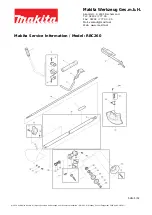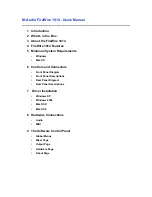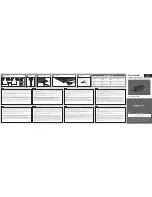
Webasto Thermosysteme
Roof-top air-conditioning system CC4E
Page 9 / 32
2.2.
Electrical components
Electrical connections for the equipment are made as shown in the circuit diagrams Figs. 3.1 and 3.2.
The CC4E is equipped with a protective circuit to prevent total exhaustion of the battery. The system is
switched off automatically if the power supply drops below 20 V for more than 10 seconds. It is restarted
by repeatedly switching on. If the system is to be operated only with "Ignition on", the ON/Off switch for the
air-conditioning system must be connected to terminal 15 (see circuit diagram on page 16).
If the system is only to be operated when the engine is running, a working contact relay must be installed
and connected via terminal D+/61 from the alternator (see circuit diagram on page 16).
The electronic system for the motor includes a soft-start function to prevent current peaks being transmitted
to the on-board supply. In addition, the electric motor is switched off automatically in the event of overloads
(i.e. current consumption > 80 A for more than 1 second) due to possible system damage.
Restarting is effected by repeatedly switching on the system.
The electric motor is switched off automatically to prevent damage to the electronics at temperatures of less
than +5 °C or more than +96 °C.
2.3.
Principle of operation of the air-conditioning system
When the air-conditioning system is switched on via the ON / OFF rocker switch on the air-distribution panel,
the electric motor starts up and drives the compressor via a poly-V-belt. The compressor compresses the
refrigerant gas and delivers it to the condenser (3) where it condenses and gives off heat.
The resultant condensation heat is transferred to the outside air flowing through the condenser (19 and 20,
Figs. 2.4 and 2.5). Two axial fans (4) maintain a sufficient air flow even when the vehicle is stationary.
The liquid refrigerant flows through the receiver-drier (13) to the expansion valve (11), where it expands as
a result of the controlled pressure drop and then reverts to the gaseous state in the evaporator (6),
absorbing heat at the same time.
The hot air (21) circulating in the driver's cab is drawn in by the radial fan (5), cooled in the evaporator, dried
and returned to the cab via the air-distribution panel (22). The resultant condensation water is collected and
discharged into the atmosphere via the drain outlet (25).
During operation, the refrigerant circuit is monitored by the anti-icing switch (12) (S2, see circuit diagram
Fig. 3.1 or 3.2) and the pressure switch (15) (S3, see circuit diagram Fig. 3.1 or 3.2). The electric motor and
consequently also the compressor are switched on and off via these two switches.
When the air-conditioning system is switched off via the ON / OFF rocker switch, the electric motor and the
fan motors are de-energized. The refrigerant circuit and recirculating-air circuit are switched off.
Rainwater entering the roof-top system is discharged via the drain outlet (24, Fig. 2.2).










































